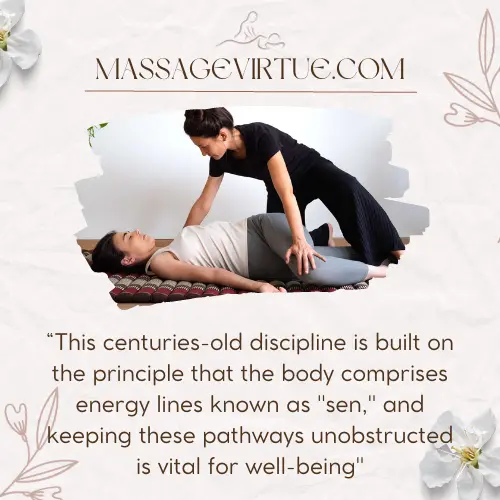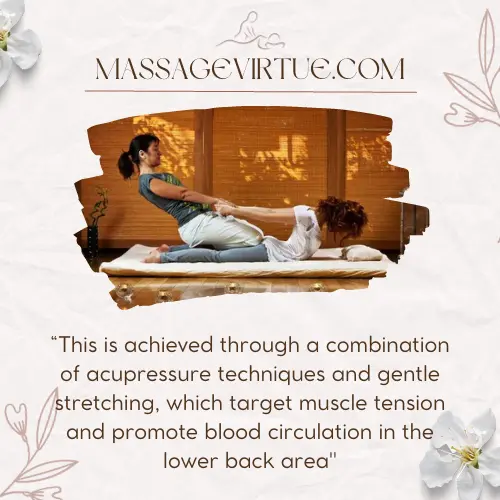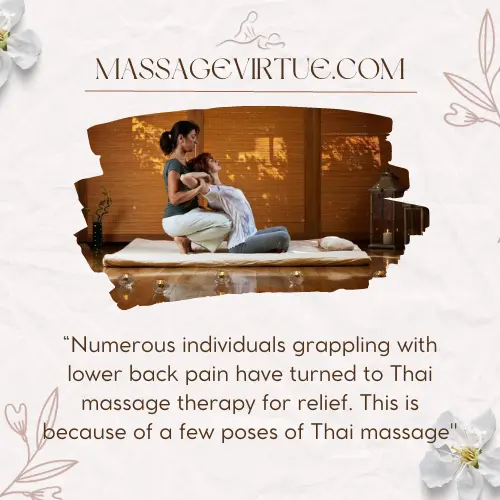In the realm of holistic wellness, few practices hold as much promise as Thai massage.
Its potential to seamlessly blend relaxation with pain relief has intrigued many, particularly those dealing with the persistent discomfort of lower back pain.
In this exploration, we will delve into the art of Thai massage to know how Thai massage help lower back pain.
We’ll also explore its historical roots and its effectiveness in promoting comfort by alleviating lower back pain.
What Is Thai Massage?
Thai massage, often referred to as “Nuad Bo-Rarn” in Thailand, represents a holistic healing tradition rooted in acupressure, yoga-inspired stretches, and energy manipulation.
This centuries-old discipline is built on the principle that the body comprises energy lines known as “sen,” and keeping these pathways unobstructed is vital for well-being.

Thai massage therapists employ hands, thumbs, elbows, knees, and feet to apply pressure and perform stretches. This technique fosters energy flow, relaxation, and balance.
Thai massage is typically conducted on a padded mat at floor level, enabling greater freedom of movement during the practice.
Other Names For Thai Massage
Thai massage is recognized internationally as “Thai Yoga Massage” or simply “Thai Bodywork.” In Thailand, it is officially called “Nuad Bo-Rarn,” which means “ancient massage.”
These diverse names reflect the practice’s holistic approach to well-being and the fusion of elements that define it.
The History Of Thai Massage
Thai massage’s origins trace back to ancient Indian and Chinese healing practices.
It is a product of the rich tapestry woven from Ayurvedic medicine, traditional Chinese medicine, yoga, and meditation.
Over time, Buddhist monks in Thailand transformed these influences into a comprehensive system focused on energy balance and holistic wellness.
How Can A Thai Massage Make You More Comfortable?
Let’s now delve into the ways in which Thai massage enhances comfort, particularly by reducing lower back pain, managing joint stiffness, and improving overall mobility.
Thai Massage Help Lower Back Pain
Thai massage has earned acclaim for its ability to gradually diminish lower back pain.
This is achieved through a combination of acupressure techniques and gentle stretching, which target muscle tension and promote blood circulation in the lower back area.

Over time, this approach can alleviate chronic pain, leading to increased comfort and an improved quality of life.
Managing Joint Stiffness
Another notable benefit of Thai massage is its effectiveness in managing joint stiffness. For many, stiff joints are a source of discomfort and restricted mobility.
Thai massage addresses joint stiffness by applying pressure to specific points and gently manipulating joints through stretches.
This not only releases tension but also enhances joint flexibility, reducing discomfort associated with stiff joints.
Extend Movement and Mobility
Thai massage excels at extending movement and mobility throughout the body.
Through its unique stretching and manipulation techniques, Thai massage improves the range of motion in joints and muscles.
This increased flexibility enhances physical comfort, promotes better posture, and contributes to overall well-being.
Thai Massage Therapy and Back Pain – Does It Work?
Numerous individuals grappling with lower back pain have turned to Thai massage therapy for relief. This is because of a few poses of Thai massage.

Let’s have a look at the different poses of the Thai massage.
Thai Massage Poses for Back Pain Relief
To address lower back pain, Thai massage incorporates specific poses and stretches designed to target key areas of tension and discomfort.
Here are some Thai massage poses that can provide relief:
- Knee to Elbow: In this posture, you lie on your back, bringing your knees toward your chest while reaching your elbows toward your knees. This stretch targets the lower back and helps alleviate tension in the lumbar region.
- Angel Twist: The angel twist entails lying on your back with your arms outstretched to the sides. One knee is drawn across the body, creating a twisting motion that releases tension in the lower back and hips.
- Prayer Pose: In the prayer pose, you sit on your knees and gently bend forward with your arms stretched out in front of you. This stretch elongates the spine and relieves pressure on the lower back.
These specific poses, when performed correctly and under the guidance of a skilled Thai massage therapist, can be instrumental in alleviating lower back pain.
Effectiveness Of Thai Massage For Lower Back Pain
Studies and anecdotal evidence suggest that Thai massage can be an effective therapy for lower back pain.
Research shows that if you suffer from chronic lower back pain, Thai massage may help reduce your pain and improve your overall quality of life.
Conclusion
In conclusion, Thai massage offers a holistic approach to addressing lower back pain and enhancing overall comfort and well-being. Its ancient roots, drawing from Indian and Chinese traditions, underscore its holistic nature.
By targeting muscle tension, promoting joint flexibility, and improving overall mobility, Thai massage has the potential to significantly reduce discomfort associated with lower back pain.
Research and anecdotal evidence suggest that Thai massage therapy can be an effective complementary approach to managing lower back pain.
For those seeking natural and holistic methods of pain relief, Thai massage poses a compelling option. Consult with a qualified Thai massage therapist to tailor sessions to your specific needs and experience the potential benefits firsthand.

